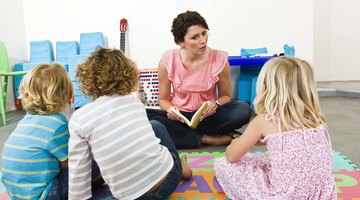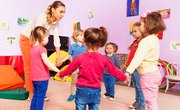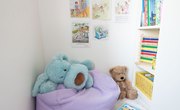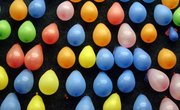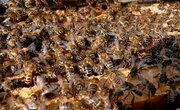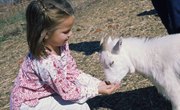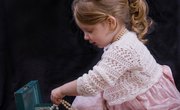While some nurseries are small with enough space for just a bed and a few toys, others are larger and can accommodate several children. If your nursery is large enough for some kiddos to gather -- or if you decide to use a family room or other space -- there are a variety of activities, including simple play, that are developmentally appropriate, fun and educational for 2- and 3-year-olds.
Floor Activities
Just before nap or after an energetic activity, the floor is a perfect area to gather children to sit for an activity, in a circle if desired. In lieu of marked spots, to get that perfect circle, children should hold hands, form a circle, let go and sit. Play "Follow the Leader." First, you can be the leader. Have the kids hold their hands above their heads, stomp their feet, wiggle their fingers and tap their heads. Children can then take turns being the leader, depending on their ages. You can also play "Duck, Duck, Goose," which is popular among the small set. In this game, whoever is "it" walks around the circle tapping the head of each child, saying, "Duck." When he taps a child's head and says "Duck, Duck, Goose" instead, that child has to try to tag the "it" child before the "it" child makes it around the circle and takes the chosen child's seat. If the chosen child doesn't tag the "it" child, he becomes the new "it." You can also just sit in circle and make animal noises and recite nursery rhymes using hand motions when possible. Or, you can read a story to the children, practice counting while clapping hands and lead the children in a song. You might want to hold out a mystery box and let the kiddos take turns feeling, but not seeing, what's inside, so they can guess what it is -- like a pine cone, stuffed animal or toy car.
Movement Activities
Children ages 2 and 3 love to move. Create a hopscotch board on the floor using masking tape so children can hop on the numbers. They can shout the number names when they jump and depending on their ages, jump on the squares in numerical order. Get their creative juices flowing by leading them in pretend activities. They can act like they're monkeys, elephants or kangaroos. They can pretend they're running away from an elephant. You can also set up an obstacle course -- and have them crawling under tables, jumping over blocks and going around chairs. Play freeze dance, instructing the kiddos that they have to immediately stop dancing when the music stops, or else they're "out." Switch it up after each freeze. Children can wiggle, jump, tip-toe or run in place while the music is going.
Learning Activities
Without even trying, children are learning through activities, such as learning numbers during the hopscotch game. Consider other activities that incorporate learning as well. If children are in your nursery one or more days a week, you could grow seeds into flowers. You can also add a link to a paper chain to count how many times kids are in the nursery. If they like, each child can have his own chain -- and hang it in the room. Explore shadows in the room with different lighting -- and play a game of shadow tag.
Independent Activities
At age 3, children are learning their colors and how to cut and glue. Give the 3-year-olds magazines and child-safe scissors and glue. You should closely supervise and help them cut out different colored pictures and shapes -- but they can glue them onto paper to create a collage. You can also set up various stations around the nursery where children can play kitchen, build with blocks, play with sand, do large floor puzzles, play with cars or color in books or on paper.
Related Articles
References
Resources
Writer Bio
Melissa Lewis is a former elementary classroom teacher and media specialist. She has also written for various online publications. Lewis holds a Bachelor of Arts in psychology from the University of Maryland Baltimore County.

